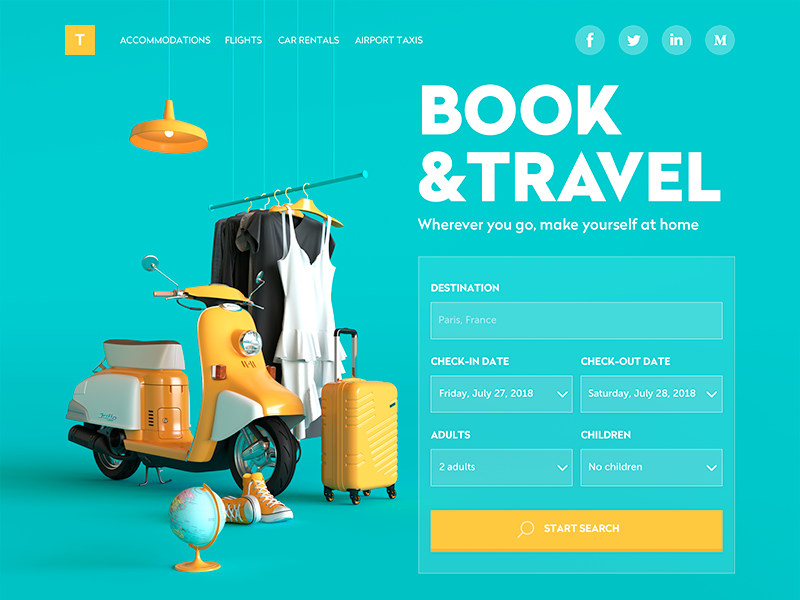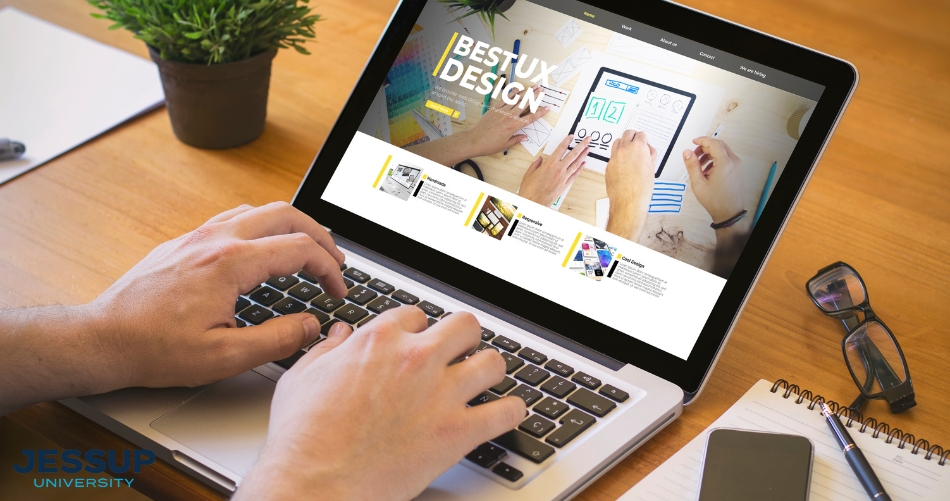Web Design London Ontario for Online Store and Local Brands
Web Design London Ontario for Online Store and Local Brands
Blog Article
Just How to Efficiently Integrate Looks and Capability in Web Design
When developing an internet site, you need to strike an equilibrium in between visual appeals and functionality. It's not practically looking excellent; your layout should also serve an objective and overview individuals effectively. By concentrating on simpleness and instinctive navigating, you can create an interesting experience. Yet what aspects really boost functionality while keeping aesthetic allure? Let's check out the crucial concepts that can cause an unified mix of charm and feature.
Comprehending the Significance of Aesthetics and Performance
When you make a web site, understanding the equilibrium between aesthetic appeals and functionality is crucial for producing an effective individual experience. A visually enticing website grabs attention, but it's the performance that keeps individuals involved. Site visitors will rapidly shed rate of interest and leave.Consider your target audience and what draws them in if your website looks great but is challenging to browse. You desire to produce a design that reflects your brand while ensuring ease of usage. Streamlined formats, intuitive navigating, and clear contact us to action can boost both aesthetics and functionality.

Concepts of Efficient Web Design
To develop a reliable internet design, you require to abide by numerous vital concepts that boost both customer experience and aesthetic charm. Initially, focus on simpleness; a clean format assists customers navigate conveniently. Utilize a consistent shade plan and typography to maintain coherence throughout your website. This fosters experience and trust.Next, assure your design is responsive. Users accessibility websites on numerous tools, so your style needs to adjust seamlessly. Take notice of aesthetic hierarchy; emphasize essential components with positioning, dimension, or shade to assist customers' focus.Finally, incorporate sufficient white area. It prevents clutter and makes content a lot more absorbable. Keep in mind, effective web layout balances aesthetic appeals and capability, so every layout choice should offer an objective. By following these concepts, you'll create a site that's not just aesthetically attractive however also user-friendly, eventually keeping visitors involved and urging them to return.
Focusing On User Experience
When prioritizing individual experience, you'll want to begin by comprehending what your customers truly need. Streamlining navigation layout can make a big distinction in how conveniently they discover what they're looking for. Improving aesthetic pecking order helps assist their interest to the most important elements on your website.
Comprehending Individual Requirements
Comprehending customer needs is essential for producing an appealing web experience that keeps site visitors returning. To attain this, you need to determine the goals and preferences of your target market. Begin by performing individual research, like meetings or studies, to collect insights on what users value most. Focus on their pain factors and difficulties when connecting with comparable sites. This info enables you to customize your style, ensuring performance aligns with user expectations. Furthermore, think about producing customer personalities that represent different sections of your audience, helping you imagine their requirements throughout the layout procedure. When you prioritize recognizing individual requirements, you develop a web site that not only looks terrific however additionally supplies a smooth, pleasurable experience that fosters commitment.
Streamlining Navigation Layout

Enhancing Aesthetic Power Structure
A solid aesthetic power structure is vital in assisting customers with your web site and ensuring they engage with crucial material. To achieve this, use size, shade, and spacing purposefully. Make vital components like headings bigger and bolder than body text, drawing attention instantly. Use contrasting shades to highlight contact us to action, motivating clicks. Additionally, employ enough white space to different areas, making content digestible and inviting.Consider the flow of info; organize components practically, leading customers' eyes from one factor to the following. Use aesthetic cues, like arrowheads or lines, to direct interest. By prioritizing visual hierarchy, you improve user experience and increase the probability of conversions, ensuring your site is both aesthetically pleasing and functionally efficient.
Color Theory and Its Effect On Functionality
While choosing the right shades for your web site may appear like a minor detail, it considerably influences use and individual experience. Color affects just how customers perceive details and can hinder or boost navigating. Contrasting shades can assist important components stand out, making it less complicated for visitors to discover what they need.Additionally, think about the psychology of colors: blue usually motivates trust, while red develops necessity. Recognizing your target audience can assist your color selections, assuring they reverberate well.Moreover, constant color pattern aid build brand name identification, making your site extra memorable. However, be cautious-- way too many shades can overwhelm users. Stick to a minimal palette that complements your material and keeps clarity.Incorporating ease of access is additionally necessary; verify your color mixes are pleasant for those with visual problems. By thoughtfully using shade theory, you'll enhance use and produce a more interesting customer experience.
Typography: Harmonizing Design and Readability
Shade choices set the stage for your web site, yet typography plays an equally necessary function in improving user experience. You desire your text to connect clearly while also showing your brand name's individuality. Start by choosing font styles that are not only appealing but additionally readable. Sans-serif font styles commonly function well for digital displays, as they're less complicated to check out at different sizes.Maintain a hierarchy by using various typeface sizes and weights; this guides customers with your material easily. Consider line spacing and letter spacing; as well tight can discourage readers, while too loose can interrupt the flow. Restriction your typeface choices to 2 or three to keep the design cohesive.Finally, constantly evaluate your typography throughout various tools and web browsers. What looks great on one screen might out an additional. Balancing design with readability warranties that your message resonates, maintaining your target market informed and involved.
Responsive Style: Making Visual Appeals Work With All Devices
To ensure your web site looks terrific on any type of device, you'll need to accept responsive design concepts. This approach warranties your site adapts to different display sizes, providing an ideal individual experience. Beginning by making use of fluid grids and versatile pictures that scale effortlessly. Rather of taken care of dimensions, go with percents and relative systems, allowing your design to change dynamically.Next, apply media questions in your CSS. These let you apply various designs based upon device features, like screen width. By doing this, you can maintain aesthetic appeal while guaranteeing functionality.Don' t ignore touch targets; make particular switches and web links are very easy to touch on smaller screens. Focus on crucial content, so users can quickly navigate your website despite their tool. By concentrating on these elements, you'll produce an appealing, aesthetically appealing experience that meets the demands of all users, whether they get on a tablet computer, smart device, or desktop .
Conducting Functionality Testing for Continuous Enhancement
To improve your website design, you require to establish clear use objectives that line up with individual needs. By performing individual tests, you can collect beneficial feedback on how real individuals interact with your site. Examining these outcomes will certainly assist you make notified enhancements and develop a much more effective user experience.
Defining Use Goals
While looks can draw users in, defining usability objectives is vital for guaranteeing their experience continues to be smooth and satisfying. Begin by recognizing what you desire users to accomplish on your website (website design london Ontario). Consider their tasks, demands, and behaviors. Are they trying to find information, buying, or registering for a newsletter? Establish clear criteria to gauge success, like task completion rates or time on job. Focus on user-friendly navigating, easily accessible material, and responsive layout to enhance functionality. Frequently revisit these goals as individual assumptions develop. By specifying usability objectives, you develop a structure for examining and boosting your site's efficiency. This emphasis on usability not just enhances individual contentment yet likewise reinforces the overall performance of your design
Carrying Out Customer Tests
Carrying out user tests is vital for refining your web site and guaranteeing it satisfies your audience's needs. Begin by identifying your target individuals and developing an examination strategy that describes your goals. Utilize a mix of measurable and qualitative techniques, such as studies, interviews, and task-based monitorings, to gather thorough feedback. Invite participants to navigate web design london ontario your website while you observe their communications and note any type of difficulties they run into. Encourage open dialogue to catch their thoughts and sensations regarding the layout and functionality. Maintain sessions brief and concentrated, ensuring you cover key areas without overwhelming customers. Lastly, make certain to document all searchings for, as this info will be vital for making educated design choices that improve both aesthetic appeals and use.
Analyzing Examination Outcomes
Just how can you effectively assess the outcomes of your use examinations to drive continuous enhancement? Beginning by categorizing comments right into common styles. Try to find patterns in customer behavior that highlight discomfort points or areas for enhancement. Use quantitative data, like task completion prices and time on task, to measure use objectively. Do not fail to remember to think about qualitative understandings from user comments; they commonly disclose underlying issues that numbers can not reveal. Prioritize one of the most impactful searchings for and develop workable products for your style group. Bear in mind, it's concerning iterating-- apply adjustments, then test once more. This cycle of screening, analyzing, and refining helps you equilibrium aesthetics and capability, ensuring your internet site meets user requirements efficiently while keeping visual charm.
Often Asked Inquiries
Exactly how Do I Select the Right Color Combination for My Internet site?
To select the right shade palette for your internet site, consider your brand's individuality, target audience, and emotional effect (website design london Ontario). Use shade psychology, produce harmony, and assurance readability. Examination combinations to see what resonates finest with site visitors
What Tools Can Aid With Web Style Visual Appeals and Performance?
You can use devices like Adobe XD, Figma, and Lay out to boost your internet layout's visual appeals and performance. These platforms use instinctive interfaces, collaboration functions, and pre-made themes to enhance your creative process and improve your designs.
Just How Can I Include Animations Without Compromising Functionality?
To include animations without compromising capability, prioritize refined impacts that enhance individual experience. Use CSS computer animations for smoother interactions, guarantee quick lots times, and examination on numerous gadgets to keep efficiency while including visual charm.
What Are Common Mistakes to Stay Clear Of in Web Style Aesthetics?
When making, prevent messy formats, bad shade options, and irregular font styles. Do not neglect mobile responsiveness, as it can estrange individuals. Confirm your design lines up with your brand name, creating a smooth experience that involves visitors effectively.
Exactly how Frequently Should I Update My Internet site's Layout for Optimum Visual Appeals?
You must upgrade your website's layout every 1-2 years to stay on top of fads and maintain suitable aesthetics. Routinely renewing visuals assists engage guarantees and visitors your site stays enticing and user-friendly. When you make a website, understanding the equilibrium between looks and capability is essential for developing an effective individual experience. To develop an effective internet style, you require to stick to numerous key concepts that enhance both customer experience and visual allure. Users accessibility internet sites on different gadgets, so your layout needs to adapt seamlessly. When focusing on user experience, you'll desire to begin by recognizing what your customers really require. Begin by conducting customer research study, like surveys or interviews, to gather understandings on what individuals value most.
Report this page